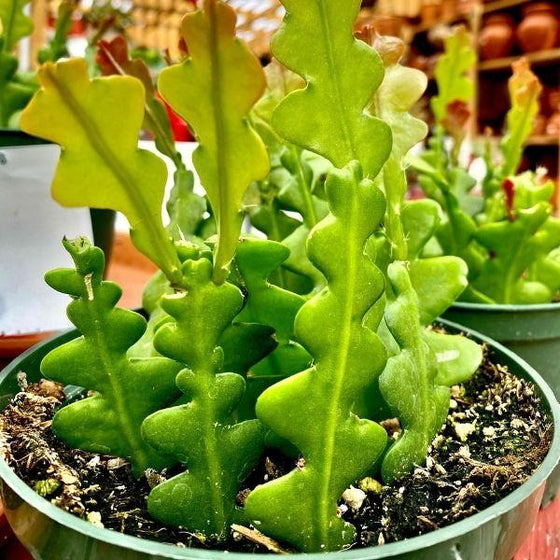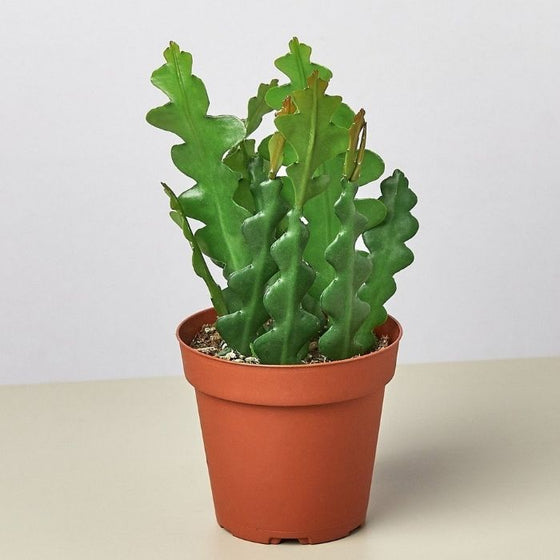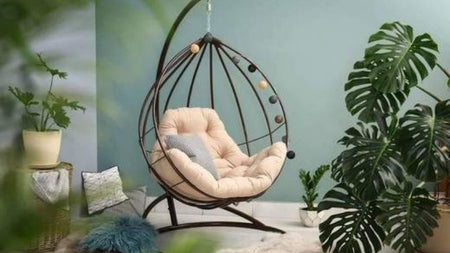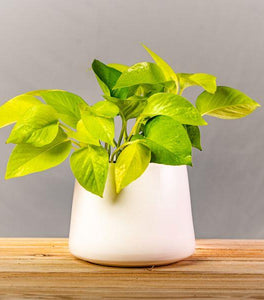
Images Depicted Range in Maturity & Container Size
Pots & Decorations Not Included Unless Otherwise Stated
Fishbone Cactus: Zig-Zag Jungle Cactus with Big Personality
A Zig-Zag Statement from the Tropics
The Fishbone Cactus (Epiphyllum anguliger) is one of those plants that looks like it came straight out of a design magazine. Instead of spines and desert sand, this jungle cactus grows flattened stems that zig and zag like cartoon fishbones—hence the name. The bright green, deeply notched foliage cascades gracefully over pot edges, turning simple shelves, hanging baskets, and plant stands into living art installations. When mature and well cared for, Fishbone Cactus can reward you with large, fragrant, night-blooming flowers, making it a true conversation starter in any plant collection.
Trailing, Cascading, and Perfect for Hanging Pots
In its native habitat, the Fishbone Cactus grows as an epiphyte, clinging to tree branches in warm, forested areas. Indoors, it exhibits the same trailing habit. Stems emerge upright at first, then arch and cascade as they lengthen, often reaching 1–3 feet long in a hanging basket or on the edge of a high shelf. The growth rate is moderate, so you’ll see steady progress without the plant taking over overnight. Over time, those zig-zagging stems layer over one another to create a complete, lush, waterfall effect that softens hard edges and adds a playful, sculptural element to any room.
Bright Indirect Light and a Chunky, Well-Drained Potting Mix are all you need
Unlike desert cacti, Fishbone Cactus is a jungle dweller. It prefers bright, indirect light or filtered sunlight—think near an east-facing window, a few feet back from a south- or west-facing window, or on a shaded porch with dappled light. Too much harsh, direct sun can scorch the stems; too little light leads to stretched, pale growth and fewer flowers. Plant it in a chunky, well-drained mix—something between an indoor potting soil and an orchid/cactus blend—with added bark, perlite, or pumice so the roots get plenty of air. Water when the top 1–2 inches of the mix feel dry, then let the excess drain away. Allow it to dry slightly between waterings, but don’t keep it bone-dry for long periods.
Hanging Baskets, Shelves, and Modern Décor
Fishbone Cactus is best used as an indoor hanging or shelf plant, where its trailing, zig-zag stems can be seen and appreciated. It’s ideal for macramé hangers, floating shelves, and plant walls that need something bold, graphic, and a little wild. In warm, frost-free climates, it can also be grown outdoors in shaded patios or under trees as a seasonal accent, as long as it’s protected from cold and heavy rain. Pair it with other tropical plants—such as philodendrons, pothos, and ferns—to create a layered jungle look, or style it solo in a clean, modern pot to let the unique fishbone shape take center stage.

| Hardiness Zone: | Best as an indoor plant; outdoors in frost-free Zones approx. 10–11 |
|---|---|
| Mature Height: | Trailing |
| Mature Width: | Trailing |
| Classification: | Epiphytic jungle cactus; tropical houseplant |
| Sunlight: | Bright, indirect light or filtered sun; avoid harsh, direct mid-day sun |
| Habit: | Hanging |
| Flower Color: | Typically late summer to fall; large, fragrant, creamy-white to yellow flowers |
| Soil Condition: | Chunky, well-draining mix (potting soil + orchid bark/perlite) |
| Water Requirements: | Water when top 1–2" are dry; let drain; do not keep constantly soggy or bone-dry |
| Uses: | Hanging baskets, high shelves, plant walls, modern decorative containers |
| Value: | Outdoors in warm climates, flowers can attract nocturnal pollinators |
How to Care for Epiphyllum anguliger (Fishbone Cactus)
Please read our planting and care instructions to keep your Fishbone Cactus happy and healthy

How should I plant Fishbone Cactus (Epiphyllum anguliger)?
To plant Fishbone Cactus, start with a pot that has drainage holes and is wider than it is deep—this suits its shallow, epiphytic root system. Fill the container with a chunky, well-draining mix made from indoor potting soil blended with orchid bark, perlite, or pumice. Gently remove your plant from its nursery pot, loosen the outer roots, and set the root mass into the new container so the top of the root ball sits level with the surrounding soil line. Backfill around the roots, firming lightly to secure the plant without compacting the mix. After planting, water thoroughly until moisture drains from the bottom, then let the pot finish dripping before placing it back in a hanger or on a shelf. Avoid burying stems too deeply—Fishbone Cactus prefers to sit just at or slightly above the soil surface, with plenty of air around the crown. Planting in spring or early summer gives it the entire growing season to settle in, but you can pot it up any time indoors if the room is warm and bright.
How often should I water Fishbone Cactus after planting?
Right after planting, give your Fishbone Cactus a deep drink to settle the mix around the roots. From then on, water when the top 1–2 inches of the mix feel dry to the touch. Jungle cacti like this appreciate a “moist then slightly dry” rhythm: they don’t want to sit in soggy soil, but they also don’t like being bone-dry for long stretches. Let water run through the pot, then empty any saucers or cachepots so excess moisture doesn’t linger at the bottom. In bright, warm rooms, you may water roughly every 7–10 days during the growing season, while in cooler or lower light conditions you’ll water less often. In winter, growth slows and the plant uses less water, so always check the mix before you water and stretch out the intervals. If stems start to wrinkle slightly, that’s often a sign it’s time for a drink; if they look mushy or yellow at the base, the plant may be staying too wet.
When should I fertilize Fishbone Cactus?
Fertilize Fishbone Cactus during the active growing season, typically from spring through early fall. Use a balanced, water-soluble fertilizer formulated for houseplants or cacti at about half the label strength every 4–6 weeks. This gentle feeding supports healthy stem growth and can encourage blooming on older, well-lit plants. Always apply fertilizer to moist soil to reduce the risk of root burn. If you prefer a more organic approach, you can use a diluted liquid seaweed or fish emulsion occasionally, or top-dress with a small amount of worm castings in spring. Avoid heavy, frequent feeding, which can lead to weak, overly soft growth. In late fall and winter, when daylight is shorter and the plant’s growth naturally slows, pause fertilizing and resume once you see new growth in spring.

When and how should I prune Fishbone Cactus?
Pruning Fishbone Cactus is primarily about shaping and tidying. Use clean, sharp scissors or pruners to remove any damaged, shriveled, or very old stems at their base. If stems are growing longer than you’d like or the plant is unbalanced, you can trim them back to the desired length, cutting just above a notch on the stem. The best time for more noticeable shaping is in spring or early summer, when the plant is actively growing and can recover quickly. The good news is that healthy stem cuttings can often be propagated. Let cut pieces callus for a day or two, then place them into a fresh, lightly moist, well-draining mix to root. Over time, selective pruning and replanting of cuttings can turn a single Fishbone Cactus into a fuller basket or several companion plants.


















